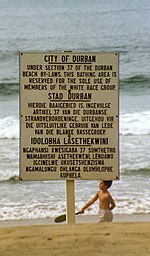
Back Waarheid-en-versoeningskommissie Afrikaans لجنة الحقيقة والمصالحة (جنوب إفريقيا) Arabic Sandheds- og forsoningskommissionen Danish Wahrheits- und Versöhnungskommission German Komisio por vero kaj repaciĝo (Sud-Afriko) Esperanto Comisión para la verdad y la reconciliación (Sudáfrica) Spanish کمیسیون حقیقت و آشتی (آفریقای جنوبی) Persian Totuus- ja sovintokomissio (Etelä-Afrikka) Finnish Commission de la vérité et de la réconciliation (Afrique du Sud) French Comisión para a Verdade e a Reconciliación (Suráfrica) Galician
| Truth and Reconciliation Commission | |
|---|---|
 | |
| Established | 1996 |
| Location | Cape Town, South Africa |
| Composition method | Court-like restorative justice |
| Authorized by |
|
| Judge term length | Promotion of National Unity and Reconciliation Act, No. 34 of 1995 |
| Type of tribunal | TRC |
| Website | www |
The Truth and Reconciliation Commission (TRC) was a court-like restorative justice[1] body assembled in South Africa in 1996 after the end of apartheid.[a] Authorised by Nelson Mandela and chaired by Desmond Tutu, the commission invited witnesses who were identified as victims of gross human rights violations to give statements about their experiences, and selected some for public hearings. Perpetrators of violence could also give testimony and request amnesty from both civil and criminal prosecution.
The Institute for Justice and Reconciliation was established in 2000 as the successor organisation of the TRC.
| Part of a series on |
| Apartheid |
|---|
 |
- ^ "What is Restorative Justice?". Suffolk University: College of Arts & Sciences, Center for Restorative Justice. Retrieved 3 February 2023.
- ^ Gade, Christian .B.N. (2013). "Restorative Justice and the South African Truth and Reconciliation Process" (PDF). South African Journal of Philosophy. 32 (1): 10–35. doi:10.1080/02580136.2013.810412. S2CID 2424224. Retrieved 3 February 2023.
Cite error: There are <ref group=lower-alpha> tags or {{efn}} templates on this page, but the references will not show without a {{reflist|group=lower-alpha}} template or {{notelist}} template (see the help page).
© MMXXIII Rich X Search. We shall prevail. All rights reserved. Rich X Search